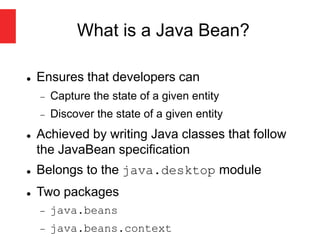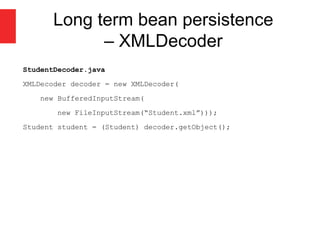Java beans
- 2. What is a Java Bean? Ensures that developers can Capture the state of a given entity Discover the state of a given entity Achieved by writing Java classes that follow the JavaBean specification Belongs to the java.desktop module Two packages java.beans java.beans.context
- 3. When is a Java class a JavaBean? When the class follows the JavaBean spec The class should only contain getters and/or setters. The class should not extend any other class or interface. Getters returning boolean values must begin with ‘is’.
- 4. When is a Java class a JavaBean? class Employee { private Integer age; public void getAge() { return this.age; } public void setAge(Integer age) { this.age = age; } }
- 5. Java Bean properties Any aspect of a Java Bean available via getter/setter methods is called a “Java bean property”.
- 6. Java Bean properties class Employee { private Integer age; public void getAge() { return this.age; } public void setAge(Integer age) { this.age = age; } public void isValidAge() { return age <= 100 && age >= 0; } } Properties – age, validAge
- 7. Java Bean properties Read-only properties – only getter method Write-only properties – only setter method Read/write properties – getter & setter
- 8. Types of Java Bean properties Indexed properties Bound properties Constrained properties
- 9. Indexed properties Basically arrays Getters return array Setters take in an array Must provide getter/setter for each element of the property
- 10. Indexed properties... Student.java public class Student { private String name; private String[] subjects = new String[] { “Maths”, “Science”, “Geography”}; public void getSubjects { return this.subjects;} public void setSubjects(String[] sub) { this.subjects = sub; } public void getSubject(int index) { return this.subjects[index]; } public void setSubject(int index, String subject) { this.subjects[index] = subject; } }
- 11. Indexed properties... Main.java public class Main { public static void main(String args[]) { Student student = new Student(); student.getSubject(2); //returns “Geography” student.setSubject(2, “Civics”); student.getSubject(2); //returns “Civics” } }
- 12. Bound properties Java bean which has listeners Changes to the bean triggers the listeners You have to write code to: Add/remove listeners Notify listeners You can have listeners for All properties Specific properties
- 13. Bound properties - Add/remove listeners java.beans.PropertyChangeSupport Provides methods to maintain a list of listeners Provides methods to notify listeners of changes
- 14. Bound properties - Add/remove listeners Student.java public class Student { private String name; private int[] marks = new int[3]; private int total; //getters & setters PropertyChangeSupport pcs = new PropertyChangeSupport(this); public void addPropertyListener(PropertyChangeListener pcl) { this.pcs.addPropertyChangeListener(pcl); } //remove property listener
- 15. Bound properties – Notify listeners To notify listeners, use methods PropertyChangeSupport.firePropert yChange PropertyChangeSupport.fireIndexed PropertyChange
- 16. Bound properties – Notify listeners Student.java public class Student { private String name; private int[] marks = new int[3]; private int total; //add/remove property listener PropertyChangeSupport pcs = new PropertyChangeSupport(this); public void setMarks(int[] marks) { this.marks = marks; int oldTotal = total; this.total = sum(marks); pcs.firePropertyChange(“total”, oldTotal, this.total);
- 17. Bound properties – listener code Listener classes Implements PropertyChangeListener Single method, propertyChange(PropertyChangeEven t evt)
- 18. Bound properties – listener code StudentRanker.java public class StudentRanker implements PropertyChangeListener { private List<Student> studentsRanking = new ArrayList<>(); public void propertyChange(PropertyChangeEvent evt) { Student source = (Student) evt.getSource(); studentsRanking.add(source); studentsRanking.sort(studentsTotalComparator); } }
- 19. Constrained properties Bound properties that have veto power over the new value being set Throw java.beans.PropertyVetoException to veto You have to write code to: Add/remove listeners Notify listeners You can have listeners for
- 20. Constrained properties - Add/remove listeners java.beans.VetoableChangeSupport Provides methods to maintain a list of listeners Provides methods to notify listeners of changes
- 21. Constrained properties - Add/remove listeners Student.java public class Student { private String name; private int[] marks = new int[3]; private int total; //getters & setters VetoableChangeSupport vcs = new VetoableChangeSupport(this); public void addVetoableChangeListener(VetoableChangeListener pcl) { this.vcs.addVetoableChangeListener(pcl); } //remove vetoable change listener
- 22. Constrained properties – Notify listeners To notify listeners, use methods PropertyChangeSupport.fireVetoabl eChange
- 23. Constrained properties – Notify listeners Student.java public class Student { private String name; private int[] marks = new int[3]; private int total; //add/remove property listener VetoableChangeSupport vcs = new VetoableChangeSupport(this); public void setMarks(int[] marks) { vcs.fireVetoableChange(“marks”, this.marks, marks); this.marks = marks; int oldTotal = total; this.total = sum(marks);
- 24. Constrained properties – listener code Listener classes Implements VetoableChangeListener Single method, vetoableChange(PropertyChangeEven t evt)
- 25. Constrained properties – listener code MarksValidator.java public class MarksValidator implements VetoableChangeListener { public void propertyChange(PropertyChangeEvent evt) { int[] marks = (int[]) evt.getNewValue(); for (int mark : marks) { if (mark < 0 || mark > 100) { throw new PropertyVetoException(“Mark is invalid.”, evt); } } } }
- 26. Bean methods Any methods that don’t meet the JavaBean spec are called bean methods
- 27. Long term bean persistence Store a bean as an XML file Useful for sharing state of beans java.beans.XMLEncoder will convert the bean into an XML file java.beans.XMLDecoder will build the bean from the XML file
- 28. Long term bean persistence – XMLEncoder Student.java public class Student { private String name; private String[] subjectsTaken; //getters & setters }
- 29. Long term bean persistence – XMLEncoder StudentEncoder.java Student student = new Student(); student.setName(“Student1”); student.setSubjects(new String[] {“Maths”, “Physics”}); XMLEncoder encoder = new XMLEncoder( new BufferedOutputStream( new FileOutputStream(“Student.xml”))); encoder.writeObject(student); encoder.close();
- 30. Long term bean persistence – XMLEncoder Student.xml <object class=”Student”> <void property=”name”> <string>Student1</string> </void> <void property=”subjectsTaken”> <array class=”java.lang.String” length=”2”> <void index=”0”> <string>Maths</string> </void> <void index=”1”> <string>Science</string>
- 31. Long term bean persistence – XMLDecoder StudentDecoder.java XMLDecoder decoder = new XMLDecoder( new BufferedInputStream( new FileInputStream(“Student.xml”))); Student student = (Student) decoder.getObject();









![Indexed properties...
Student.java
public class Student {
private String name;
private String[] subjects = new String[] { “Maths”,
“Science”, “Geography”};
public void getSubjects { return this.subjects;}
public void setSubjects(String[] sub) { this.subjects =
sub; }
public void getSubject(int index) { return
this.subjects[index]; }
public void setSubject(int index, String subject) {
this.subjects[index] = subject; }
}](https://image.slidesharecdn.com/javabeans-180519174214/85/Java-beans-10-320.jpg)
![Indexed properties...
Main.java
public class Main {
public static void main(String args[]) {
Student student = new Student();
student.getSubject(2); //returns “Geography”
student.setSubject(2, “Civics”);
student.getSubject(2); //returns “Civics”
}
}](https://image.slidesharecdn.com/javabeans-180519174214/85/Java-beans-11-320.jpg)


![Bound properties -
Add/remove listeners
Student.java
public class Student {
private String name;
private int[] marks = new int[3];
private int total;
//getters & setters
PropertyChangeSupport pcs = new
PropertyChangeSupport(this);
public void addPropertyListener(PropertyChangeListener pcl)
{
this.pcs.addPropertyChangeListener(pcl);
}
//remove property listener](https://image.slidesharecdn.com/javabeans-180519174214/85/Java-beans-14-320.jpg)

![Bound properties –
Notify listeners
Student.java
public class Student {
private String name;
private int[] marks = new int[3];
private int total;
//add/remove property listener
PropertyChangeSupport pcs = new
PropertyChangeSupport(this);
public void setMarks(int[] marks) {
this.marks = marks;
int oldTotal = total;
this.total = sum(marks);
pcs.firePropertyChange(“total”, oldTotal, this.total);](https://image.slidesharecdn.com/javabeans-180519174214/85/Java-beans-16-320.jpg)




![Constrained properties -
Add/remove listeners
Student.java
public class Student {
private String name;
private int[] marks = new int[3];
private int total;
//getters & setters
VetoableChangeSupport vcs = new
VetoableChangeSupport(this);
public void
addVetoableChangeListener(VetoableChangeListener pcl) {
this.vcs.addVetoableChangeListener(pcl);
}
//remove vetoable change listener](https://image.slidesharecdn.com/javabeans-180519174214/85/Java-beans-21-320.jpg)

![Constrained properties –
Notify listeners
Student.java
public class Student {
private String name;
private int[] marks = new int[3];
private int total;
//add/remove property listener
VetoableChangeSupport vcs = new
VetoableChangeSupport(this);
public void setMarks(int[] marks) {
vcs.fireVetoableChange(“marks”, this.marks, marks);
this.marks = marks;
int oldTotal = total;
this.total = sum(marks);](https://image.slidesharecdn.com/javabeans-180519174214/85/Java-beans-23-320.jpg)

![Constrained properties – listener
code
MarksValidator.java
public class MarksValidator implements VetoableChangeListener {
public void propertyChange(PropertyChangeEvent evt) {
int[] marks = (int[]) evt.getNewValue();
for (int mark : marks) {
if (mark < 0 || mark > 100) {
throw new PropertyVetoException(“Mark is
invalid.”, evt);
}
}
}
}](https://image.slidesharecdn.com/javabeans-180519174214/85/Java-beans-25-320.jpg)


![Long term bean persistence
– XMLEncoder
Student.java
public class Student {
private String name;
private String[] subjectsTaken;
//getters & setters
}](https://image.slidesharecdn.com/javabeans-180519174214/85/Java-beans-28-320.jpg)
![Long term bean persistence
– XMLEncoder
StudentEncoder.java
Student student = new Student();
student.setName(“Student1”);
student.setSubjects(new String[] {“Maths”, “Physics”});
XMLEncoder encoder = new XMLEncoder(
new BufferedOutputStream(
new FileOutputStream(“Student.xml”)));
encoder.writeObject(student);
encoder.close();](https://image.slidesharecdn.com/javabeans-180519174214/85/Java-beans-29-320.jpg)

